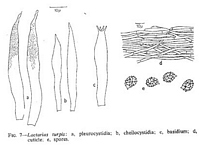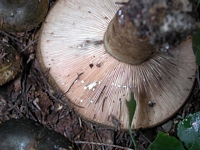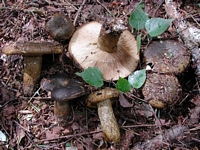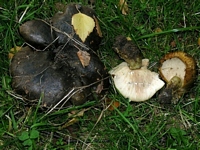|
 Lactarius turpis Lactarius turpis
SynonymsAgaricus turpis
Lactarius plumbeus
BiostatusPresent in region - Exotic
Images (click to enlarge) | 
Caption: fruitbody
Owner: J.A. Cooper | 
Caption: fruitbody
Owner: J.A. Cooper | 
Owner: J.A. Cooper | |
Article: McNabb, R.F.R. (1971). The Russulaceae of New Zealand. 1. Lactarius DC ex S.F. Gray. New Zealand Journal of Botany 9(1): 46-66 (http://www.rsnz.org/publish/abstracts.php).
Description: pileus: 7-23 cm diam. convex when young, centrally depressed at maturity, viscid under wet conditions, otherwise dry, azonate, finely felted or subtomentose when young, ± glabrous or occasionally with fine adpressed squamules at maturity, drab olive brown or dark brownish black with olive brown tints, paling towards margins; margins ochraceous, strongly involute, and coarsely tomentose when young, slightly involute and felted or subtomentose at maturity. Cuticle gelatinised, composed of ± repent, interwoven, hyaline, thin-walled or moderately thin-walled, septate hyphae 2-6.5 µm diam. lamellae: adnate to subdecurrent, crowded, moderately thin, simple, to 6 mm deep, pallid cream with ochraceous tints when young, cream with dull brownish edges at maturity, discoloured with dull brown spots and stains; lamellulae present in 3-4 unequal series; latex copious, viscid, creamy white, unchanging on exposure to air, drying dull creamy white. stipe: 3-7 cm long ± equal, stout, 2-3.5 cm diam., solid, subglabrous, sometimes finely felted-velutinate apically, ± concolorous with pileus or slightly paler, often with greenish tints apically; flesh white, browning slightly on prolonged exposure to air. Cuticle similar to that of pileus. spores: spore print ochraceous buff; spores broadly elliptical, obliquely apiculate, apiculus to 1.5 µm long, 6.5-8.5-(9.5) X 5-7 µm, ornamentation of moderately coarse amyloid ridges to 0.7 µm high forming an almost complete reticulum; plage indistinct. hymenium: basidia hyaline, subclavate to clavate, 35-51 X 6.5-10.5 µm, 4-spored, sterigmata to 7 µm long: pleurocystidia numerous, scattered, fusiform to lanceolate, hyaline, thin-walled, contents finely granular and refractive in KOH, projecting to 30 µm beyond basidia, 52-87 X 6.5-10 µm; cheilocystidia numerous, fusiform, hyaline, thin-walled, 34-54 X 4-8 µm; pseudo-cystidia sparse, scattered, originating from lactiferous hyphae, irregularly cylindrical, not or only slightly projecting beyond basidia, to 6.5 µm diam. hymenophoral trama: homiomerous, composed of interwoven lactiferous hyphae and short-celled connective hyphae; subhymenium of closely interwoven, short-celled hyphae appearing cellular in section. context of pileus: white, slightly browning on prolonged exposure to air, thick, firm, rather coarsely granular. smell: not distinctive. taste: lamellae extremely acrid, context slightly acrid. chemical characters: formalin - slowly faint salmon pink: phenol - slowly purplish-red; FeSO4 - faint salmon pink; guaiacol - slowly faint salmon pink darkening with time; KOH on pileus - rapidly deep purplish; on context - faintly purple; NH4OH on pileus - rapidly deep purple with lighter purple flush: on context - faint purple
Notes: There is some controversy over the correct name for this species and it is sometimes called Lactarius necator. The fungus described and illustrated by Bulliard (1791) as Agaricus necator was subsequently redescribed by Persoon (1801), and although Persoon referred to Bulliard's plate, there is little doubt that the fungus described by Persoon was not A. necator Bull. When the name was revalidated by Fries (1821), the description of A. necator agreed with that of Persoon but not with that of Bulliard. It appears that in revalidating A. necator. Fries misinterpreted the species. For this reason Bulliard's name has been rejected in favour of A. turpis Weinm. by most recent workers (Neuhoff, 1956; Dennis, et al. 1960). On the other hand. Singer (1962) considered that Fries misinterpreted Agaricus turpis Weinm. when he transferred the name in 1838, and cited the species as Lactarius necator (Bull. em. Pers. ex Fr.) Karst.
Lactarius turpis is an introduced species commonly associated with Betula pendula throughout the South Island, It is indigenous to temperate regions of the Northern Hemisphere where it is typically associated with birches. The species is considered poisonous by European mycologists. Pilat (1961) stated that it is poisonous when raw or poorly cooked, but is edible although not recommended when the latex is soaked out. Lactarius turpis is readily recognisable by the large, stoutly stipitate, drab olive brown or brownish black frutifications, discoloured lamellae, and extremely acrid taste. The purple discolouration of the pileus with KOH and NH4OH is also characteristic. The species was placed in sect. Lactarius subsect. Vietini stirps Necator by Singer (1962).
|